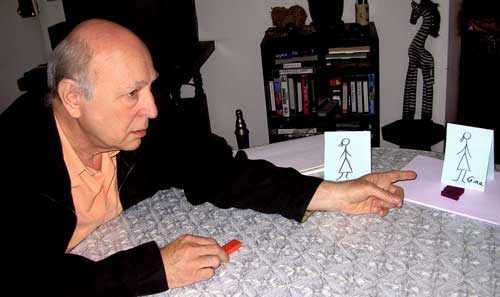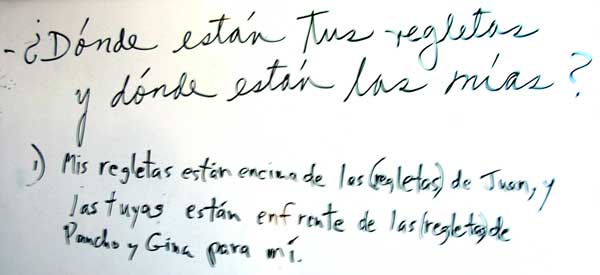 Studying
Spanish The Silent Way
Studying
Spanish The Silent Way
 Studying
Spanish The Silent Way
Studying
Spanish The Silent Way
A first-time visitor to Mexico
comments on language learning and Guadalajara
Photos ©2010 by John Pint
See the Video Clip on Youtube!
Some time ago, retired computer programmer Jon Levy of Washington, D.C.,
decided he would take up the study of a foreign language “because it would be
good for the brain.” For no particular reason, Levy picked Spanish as his target
language and began hunting for a good way to study it. “I started with the
Pimsleur Method,” he says. This system is based on listening to recordings and
repeating, but, continues Levy, “I found it wasn’t working for me. I wasn’t
doing as much as I had to in order to learn it.”
Not about to give up, Levy next tried Rosetta Stone, a computer-based self-study
approach which helps students figure out a new language for themselves. “I
really liked Rosetta Stone and I did it for a couple of month, but then I
started getting frustrated.” Levy had come upon aspects of Spanish which he was
unable to puzzle out for himself, so he stopped using this method and joined an
on-line class offered by a local community college. This program, however,
bombarded him with vocabulary. “By the third week,” he complains, “I had
forgotten what I learned the first week.”
Levy then recalled a demonstration Portuguese lesson he had seen long ago in
1965 of an approach called The Silent Way. He had been so impressed by the
lesson he’d seen that he still recalled the name of the teacher, Dr. Caleb
Gattegno (1911-1988, creator of The Silent Way).
 Levy
used the internet to hunt for a Spanish-the-Silent-Way course and was only able
to find one person in the world offering such classes: Susana Ibarra de Pint of
Guadalajara.
Levy
used the internet to hunt for a Spanish-the-Silent-Way course and was only able
to find one person in the world offering such classes: Susana Ibarra de Pint of
Guadalajara.
“I thought going to Mexico would be nice,” said Levy—“I had never been there before and I liked the idea of having someone to show me around. For me, this was all very daring—but I did it.”
On April 11, Levy flew to Guadalajara and the next day began studying Spanish five hours per day in Pinar de la Venta, a rustic community located just west of the city, at the edge of the Primavera Forest.
“I was never bored,” he commented, “and I was always learning. I never had
this kind of educational experience before—so intense. But now, at the end of
the one-week course, I feel I have the basis I need for continuing on by myself,
which I never felt with other methods. When I get back to the U.S., I’m going to
join one of those Spanish conversation groups—and now I’m ready to go back to
the Rosetta Stone.”
|
My rods are on top of Juan's and yours are (for me) in front of Pancho and Gina's . (Written work on the third day of the five-day course.) |
 |
The Silent Way was so named in order to contrast it with language-teaching methods where the teacher shouts out phrases and the students repeat. In the Silent Way, the students are engaged in a game-like situation where they discover how the new language works by trial and error, a bit like all human beings do as small children, when they learn their first language.
The Silent Way was developed
by Egyptian-born Dr.
Caleb Gattegno, the innovative educator who introduced the
Cuisenaire rods into many of the world’s classrooms, first for teaching and
learning math and later for studying foreign languages. Gattegno also developed
an approach to teaching reading (of one’s native language) called Words in
Color. All of his educational approaches are based on “the subordination of
teaching to learning,” a principle which requires teachers to constantly revise
and adjust what they are doing in the classroom according to the ever-changing
requirements of the students’ learning. In 1968, Gattegno founded
Educational Solutions, Inc. in
New York City. This organization and
Une
Education Pour Demain in France are the world leaders in carrying on Caleb
Gattegno's work.
| Apart from studying Spanish for 25 hours, Jon Levy was also taken by his teacher to visit local attractions like Tlaquepaque and Los Guachimontones. He says, “Mexico is quite different from the U.S.. People here are very hard-working. In the family I stayed with, the husband left for work at 7:00 AM and returned at 9:00 PM. On the streets, at stoplights, people are washing windshields, juggling and selling things, trying to make money any way they can. In New York, where I grew up, we call that hustling. Americans do work hard, but not like down here.”
Jon Levy and Susana Ibarra with sculptures of Alejandro Colunga,
permanently on display in downtown Guadalajara. “I was impressed by how much
creativity I saw in Mexico,” said Levy. |
 |
John Pint

Tus regletas están entre las de Juan y Vicky: Your rods are between Juan and Vicky's.

1) Each of us has a rod of the same color.
2) We both have a rod of the same color

Jon Levy of Washington, D.C. (right) studies the master plan being followed by Guadalajara muralist Jorge Monroy (left) for the new Teuchitlan Interactive Museum.